Exploring Large Bird Enclosures: Design and Benefits
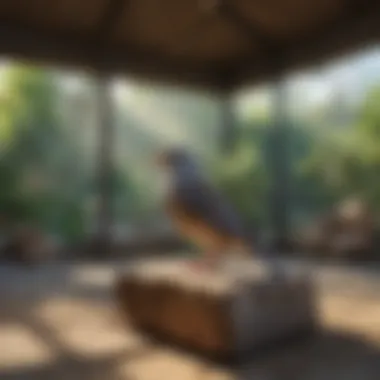
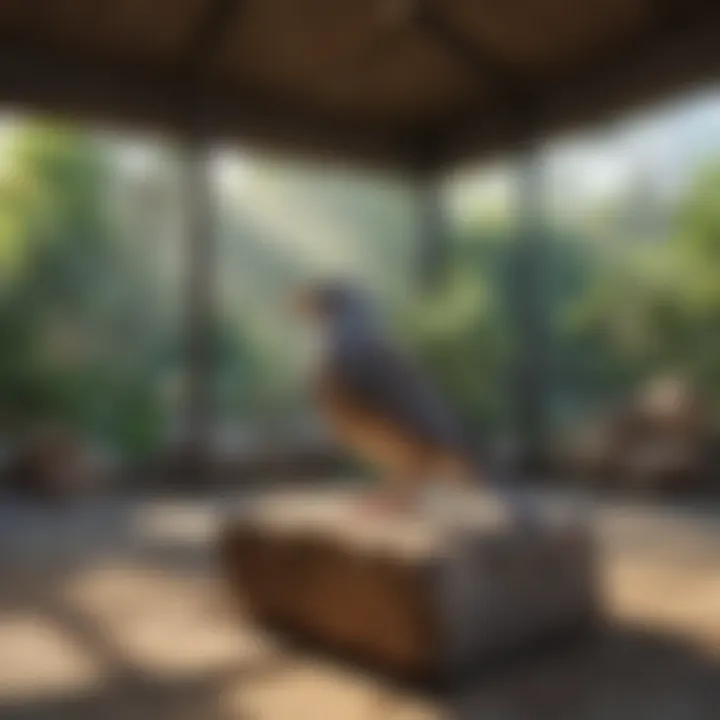
Intro
Large bird enclosures are crucial for providing a healthy and stimulating environment for pet birds. With the right design and care, these spaces not only promote physical health but also contribute to the mental well-being of the avian inhabitants. In this article, we will explore key aspects of large bird enclosures, including design, materials, and maintenance practices. A well-constructed enclosure enriches the life of pet birds and enhances the experience of their owners.
Care Tips
Daily Care Routines
Routine care is essential for the well-being of pet birds. Daily tasks should include feeding, providing fresh water, and checking toys for wear. Observing your bird during these interactions can offer insights into their health and mood. Ensuring a consistent schedule can help birds feel secure and understood.
Cage Setup and Maintenance
A well-thought-out cage setup can maximize space and safety. Choose appropriate dimensions based on your bird's species. Larger birds require more space to move, while smaller birds may enjoy complex setups.
- Use non-toxic materials for perches and accessories.
- Ensure proper ventilation within the enclosure.
- Think about creating various levels with platforms.
Maintenance should involve a weekly deep clean and regular checks on the structural integrity of the cage. Damaged areas or worn-out toys should be addressed immediately.
Hygiene and Cleaning Practices
Maintaining cleanliness is vital. The enclosure should be cleaned thoroughly to prevent the risk of disease. Use bird-safe cleaning agents and regularly wash water bowls and food dishes.
- Clean cages with vinegar solution.
- Remove droppings daily.
- Sanitize perches and toys periodically.
Seasonal Care Adjustments
Birds may require different care during changing seasons. Heat can lead to overheating, while cold can be uncomfortable. This means ensuring the enclosure is adequately insulated or cooled, depending on the weather. Adjusting light exposure mimics natural conditions and helps regulate your bird’s circadian rhythm.
Behavioral Insights
Understanding Bird Body Language
Understanding bird body language allows owners to connect more effectively with their pets. Signs of contentment include soft vocalizations and relaxed posture. Conversely, ruffled feathers and aggressive vocalizations may indicate stress or discomfort.
Common Behavioral Issues and Solutions
Issues such as excessive screaming or feather plucking can occur. Identifying the cause is crucial. It may stem from boredom or lack of social interaction.
- Increase engagement through toys or social play.
- Provide a consistent environment to reduce anxiety.
Positive Reinforcement Techniques
Using positive reinforcement helps encourage desirable behaviors. Rewarding birds with treats or verbal praise for good behavior reinforces those actions, creating a positive feedback loop.
Social Interaction Needs
Birds are social creatures. They thrive on interaction, whether with humans or other birds. Establishing regular interaction times fosters a strong bond and prevents loneliness.
Nutrition Guides
Essential Diet Components
A balanced diet includes pellets, seeds, and fresh fruits and vegetables. Each species has unique nutritional needs, so it is essential to tailor the diet accordingly.
Safe and Toxic Foods
Certain foods are safe and beneficial, while others can be harmful. Educating oneself on safe foods is paramount.
- Safe items: spinach, carrots, apples.
- Toxic items: chocolate, avocado, caffeine.
Supplements and Treats
Occasional treats can be offered, but they should complement a balanced diet instead of replacing it. Additional supplements might be useful during molting or breeding periods.
Feeding Strategies for Different Species
Different species require distinct feeding strategies. For example, larger birds may need more complex diets than smaller finches. Understand the requirements of various species to ensure proper health.
Wellness and Health
Routine Health Checkups
Regular veterinary check-ups are critical in maintaining the health of your bird. Avian specialists are trained to identify issues that may go unnoticed.
Identifying Symptoms of Illness
Being observant is essential. Symptoms such as lethargy, changes in appetite, or altered droppings are signs of possible illness that should prompt immediate veterinary attention.
Preventative Care and Vaccinations
Vaccinations may be necessary to protect birds from specific diseases. Preventative care also includes maintaining a clean environment and appropriate diet.
Mental and Emotional Well-being
Birds benefit from mental stimulation. This can be achieved through social interaction, toys, and environmental enrichment.
Enriching Activities
Toys and Playtime Ideas
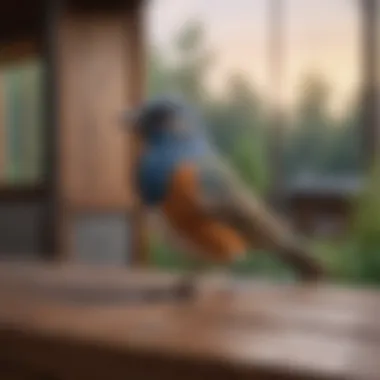
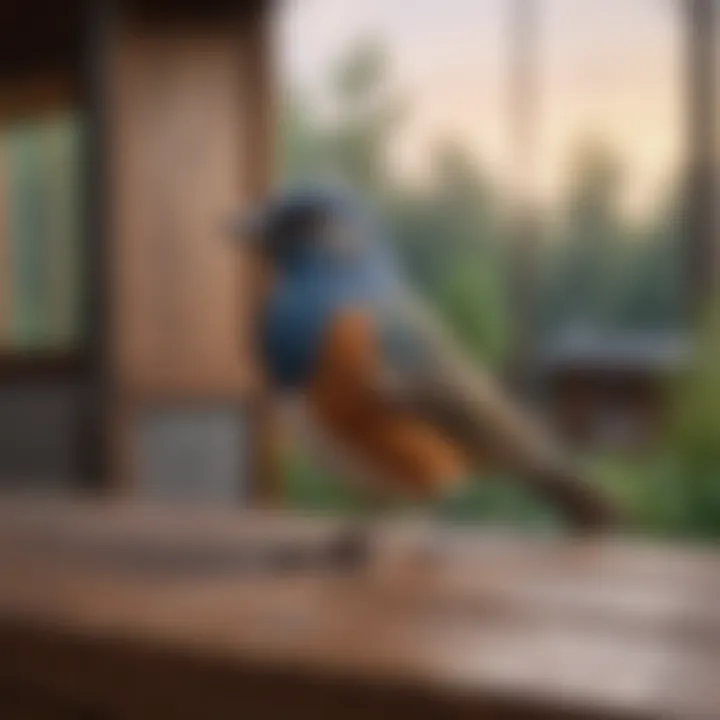
Provide various toys to promote mental engagement. Rotate them regularly to maintain interest. Items such as foraging toys can stimulate natural behaviors.
Training and Tricks
Training birds using simple commands can strengthen bonds and provide mental challenges. Positive reinforcement should be the foundation of any training session.
Outdoor Activities and Interaction
When safe, letting birds experience the outdoors can be beneficial. Supervised outings provide new sights, sounds, and experiences that enrich their lives.
DIY Projects for Mental Stimulation
Simple DIY projects, like creating foraging toys from household items, can engage birds and stimulate their natural instincts.
This comprehensive approach to bird enclosure design and maintenance ensures a prosperous and fulfilling environment for both the birds and their caregivers. By considering the needs of pet birds, owners can contribute to their overall well-being.
The Importance of Large Bird Enclosures
Large bird enclosures serve as critical habitats for pet birds, offering them the chance to thrive in environments designed to meet their specific needs. These enclosures are not merely spacious structures; they represent a commitment to avian welfare, allowing birds to engage in natural behaviors that significantly contribute to their quality of life. This section will discuss the fundamental role these enclosures play in fostering a healthy and stimulating environment.
Understanding the Needs of Pet Birds
Birds are complex creatures with intricate physical and psychological needs. Large bird enclosures provide the necessary space that enables birds to exercise, interact socially, and explore their surroundings. Essential elements include appropriate perches, climbing opportunities, and room for flight. When designed well, these enclosures can help replicate the wild environments birds naturally inhabit, thus fulfilling their behavioral and environmental needs.
Why Space Matters
Space is not just a luxury for pet birds; it is a necessity that impacts their overall well-being in several profound ways.
Physical Exercise
Physical exercise is vital for maintaining a bird's health. In large enclosures, birds can flap their wings, explore different levels and surfaces, and engage in playful activities that promote muscle tone and cardiovascular health. The key characteristic of physical exercise in this context is the freedom it offers. Birds allowed to move freely in a spacious environment are more likely to stay healthy and active, reducing the risk of obesity and related diseases.
Moreover, providing ample space for exercise encourages playful behavior, which is intrinsic to many bird species. This space not only supports physical health but also contributes positively to their emotional state.
Social Interaction
Social interaction is another critical aspect of bird behavior that large enclosures support effectively. Many pet birds, such as parrots, are inherently social animals that thrive on companionship. In larger spaces, they can engage with other birds or interact with humans more naturally. The key characteristic of social interaction within these enclosures is that it promotes bonding, helps in reducing loneliness, and fosters behavioral health.
The unique role of social interaction in large environments means that birds can express themselves fully. Without sufficient space, aggressive behaviors may emerge due to stress or territoriality. The benefits are clear: larger enclosures lead to happier, less stressed birds, which makes the overall management of their behavior much easier.
Exploration and Enrichment
Exploration and enrichment are essential for preventing boredom and encouraging stimulating activities that can significantly enhance a bird's cognitive function. A well-designed large enclosure offers various features like toys, climbing structures, and hiding spaces where birds can explore. The key characteristic here is the variety of stimuli available.
Being able to explore encourages innate curiosity, leading to mental stimulation. In turn, enriched environments allow birds to engage in problem-solving behaviors, enhancing their overall cognitive development. This enrichment often results in healthier birds that live longer and are less prone to behavioral issues. Therefore, the thoughtful design of enclosures, that promotes exploration and provides varied activities, is integral to avian well-being.
"A spacious environment is the foundation of a bird’s well-being. It is not just about having room; it's about what that space allows them to do."
Designing Large Bird Enclosures
Designing large bird enclosures is a crucial aspect of ensuring the well-being of pet birds. The design influences many factors, from the physical environment to the psychological welfare of these creatures. A thoughtfully designed enclosure can provide ample space for movement, social interaction, and exploration, which are all vital for a bird's health. Each element of the design should be tailored to meet the species-specific requirements, enhancing not only the life of the pet but also the experience of the bird owners. By understanding the fundamental principles of good design, owners can create spaces that contribute positively to the birds’ physical and emotional states.
Space Planning Principles
Space planning for large bird enclosures involves careful consideration of layout, accessibility, and flow. An effective design begins with an understanding of the birds' natural behaviors. Pet owners must recognize that birds thrive in environments that allow them to move freely. An enclosure should provide various pathways and areas for exploration.
Moreover, it’s essential to create a plan that allows easy access for cleaning and maintenance. This balance between accessibility and natural navigation is critical in avoiding stress within the bird population. A well-planned space encourages activity and engagement, which fosters overall bird welfare.
Choosing Appropriate Dimensions
Selecting the right dimensions for an enclosure is fundamental, as it directly impacts the birds' quality of life. The dimensions should accommodate the specific needs of the bird species. Larger species might require larger spaces to fly, while smaller varieties benefit from vertical space where they can perch and play.
- Height is particularly important. Many birds enjoy climbing and require tall spaces to exhibit natural behaviors.
- Width and depth must also be considered. A larger base allows for more ground activity and prevents overcrowding.
Without appropriate dimensions, birds might become stressed, leading to behavioral issues or health risks, which undermines the goal of providing a suitable habitat.
Creating Different Zones
Creating distinct zones within the enclosure offers birds a variety of environments that cater to their different needs. This segmentation can enhance the overall layout, ensuring that birds have access to looking after their varied interests. The main zones typically include resting areas, play zones, and feeding stations.
Resting Areas
Resting areas in a large bird enclosure serve as essential sanctuaries for pet birds. These areas should be well-placed to ensure privacy while allowing for observation of the surroundings. The main characteristic of a resting area is its comfort. Providing natural materials like branches or soft surfaces promotes relaxation.
Having a designated resting zone is beneficial, as it allows birds to feel safe and secure away from more active sections of the enclosure. Additionally, it minimizes conflict among birds by offering them a quiet place to retreat when needed.
Play Zones
Play zones are integral to a bird's mental stimulation and physical health. These areas should include perches, swings, and various toys that encourage interaction. The highlight of play zones is the opportunity for birds to exhibit their playful nature. Birds need this engagement to prevent boredom, which can lead to destructive behaviors.
Creating innovative play zones can be a valuable choice for pet owners. However, owners must ensure these spaces are safe and constructed from non-toxic materials, as overly complicated designs may pose risks of injury.
Feeding Stations
Feeding stations are vital for the proper nutrition of pet birds. These should be strategically placed to discourage territorial disputes among birds. A key characteristic of feeding stations is accessibility. Birds should have easy access to their food, and placements should prevent overcrowding during feeding times.
Moreover, a unique feature of feeding stations is the potential for variety. Incorporating different types of food and feeders can promote enriched diets and encourage interaction during meal times. This offering is thought to promote healthy eating habits among birds in large enclosures.
Ultimately, carefully designed zones enhance the environment, making it not only functional but also enjoyable for pet birds. This comprehensive approach ensures all aspects of a bird's behavior and health are considered.
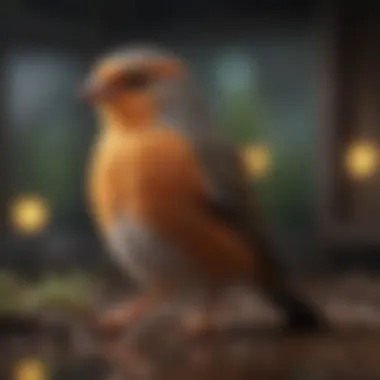
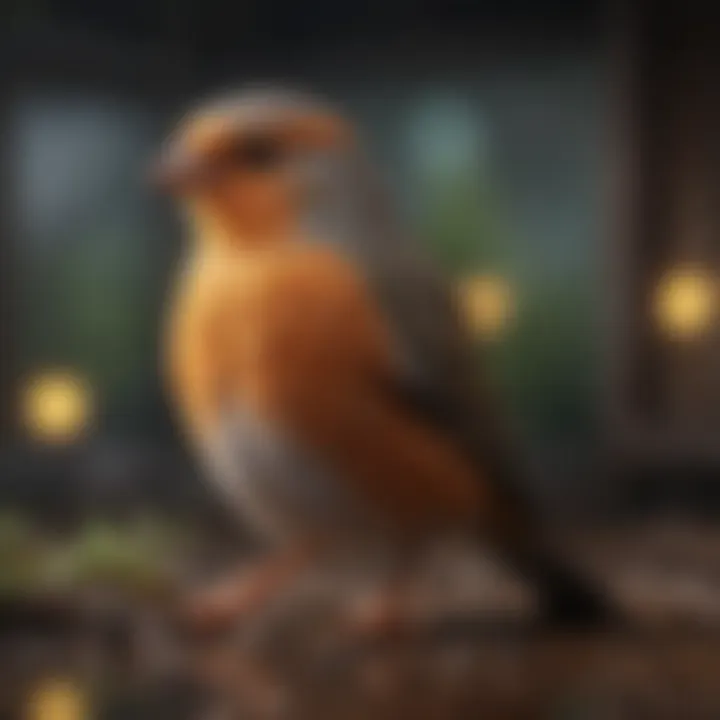
Materials for Large Bird Enclosures
Materials used in the construction of large bird enclosures play a crucial role in the health and well-being of the birds. The choice of materials directly impacts not only the safety and comfort of the birds but also the durability and maintenance needs of the enclosure itself. Selecting the right materials can benefit avian inhabitants tremendously by creating a secure and stimulating environment. Each type of material has its own characteristics, drawing attention to key advantages and potential drawbacks that pet bird owners should consider.
Types of Construction Materials
Wood
Wood is a widely used material in creating bird enclosures. Its main benefit lies in its natural aesthetic, which can enhance the overall appearance of the enclosure. Many birds feel comfortable in wooden environments, as it mimics their natural habitats. Additionally, wood is generally easy to work with, which allows for flexibility in design and customization.
However, wood can be susceptible to moisture and pests. This susceptibility may lead to quicker degradation if not treated properly. Even though wood has a pleasing look, it requires regular maintenance to ensure that it remains safe and hygienic for birds. Unfinished or untreated wood can harbor bacteria which is not ideal for health concerns.
Metal
Metal offers several advantages in constructing bird enclosures, particularly in terms of strength and durability. Metal structures withstand external elements better than wood and often require less maintenance. Enclosures made from metal can also provide better security against predators, ensuring that the birds remain safe.
Another characteristic of metal is that it can be molded into various shapes and sizes, thus allowing for creative designs. However, metal enclosures may become very hot in direct sunlight, which could be uncomfortable for the birds. Proper ventilation and shade must be included when using metal to ensure that the birds do not experience heat stress.
Wire Mesh
Wire mesh is essential in ensuring an open yet secure environment for birds. This material provides excellent visibility and ventilation. The key feature of wire mesh is that it allows for sunlight and airflow while keeping the birds safe from potential threats. It can be installed in various configurations, thus enabling flexibility in design.
However, choosing the correct gauge and type of wire is critical. Too thin a wire might not hold up against aggressive birds or larger predators. Furthermore, some birds may chew on the wire, leading to potential injury. Thus, selecting a durable wire mesh that adequately protects the birds is fundamental.
Choosing Safe and Durable Options
When selecting materials for bird enclosures, safety and durability must be overarching priorities. It is essential to choose non-toxic materials, particularly treatments applied to woods or metals. Look for paints or coatings that are specifically designed to be safe for animals. In addition, the longevity of materials can reduce long-term costs for enclosures, making it a wise investment for bird owners.
Understanding how these materials work and their alignment with specific avian needs will aid in crafting an adequate and enriching environment for birds.
Maintenance of Large Bird Enclosures
Maintaining large bird enclosures is an essential aspect of creating a healthy and enriching environment for pet birds. Proper maintenance not only ensures the cleanliness of the habitat but also minimizes the risk of illness and promotes overall well-being. Bird owners should recognize that a well-maintained enclosure positively affects their birds' behavior and quality of life.
Two key components of maintenance are regular cleaning protocols and inspecting for damage. These components should be prioritized by pet bird owners, as they contribute significantly to both the practical and emotional health of the birds.
Regular Cleaning Protocols
Regular cleaning protocols are crucial for maintaining hygiene and comfort within large bird enclosures. Effective cleaning routines can directly influence the health of birds, keeping them safe from harmful bacteria and parasites.
Daily Tasks
Daily tasks involve routine activities that help keep the enclosure tidy and safe. These tasks may include removing uneaten food, cleaning water bowls, and checking that toys and perches are free from droppings.
The key characteristic of daily tasks is their immediacy. Addressing messes quickly prevents the build-up of waste and reduces odor, which can be distressing for both birds and their owners. This proactive approach is a beneficial choice for maintaining enclosures, as consistent care fosters a healthier living space.
One unique feature of daily tasks is their flexibility. They can be adjusted based on the number of birds and their specific habits. However, relying solely on daily cleaning might not be sufficient to combat deeper cleanliness issues that arise over time.
Weekly Deep Cleaning
Weekly deep cleaning involves thorough scrubbing, disinfecting, and replacing bedding within the enclosure. This comprehensive approach targets areas that daily cleaning may overlook, like corners where debris can accumulate.
The key characteristic of weekly deep cleaning is its depth. This method provides a more extensive sanitation process and eliminates pathogens that might cause health issues. It is a favored technique for long-term maintenance as it ensures a clean environment and re-establishes hygiene in all parts of the enclosure.
A unique feature of weekly deep cleaning lies in its requirement for a more thorough check of the enclosure's integrity. This includes assessing the condition of the materials used for construction. The main disadvantage is that it requires more time and effort; therefore, it may not be as popular with all owners.
Inspecting for Damage
Inspecting for damage is a critical part of the maintenance routine. Over time, even well-constructed enclosures can suffer from wear and tear. This may range from rust on metal components to splintering wood.
Regular inspections allow bird owners to identify these issues before they become serious. Not only does this prevent the risk of injury to the birds, but it also prolongs the life of the enclosure. Bird owners should establish a schedule for these checks, ideally conducted monthly, to ensure that all components remain safe and functional.
The importance of maintenance cannot be overstated. For pet bird owners, establishing a routine for both cleaning and inspection not only contributes to a healthier environment but also promotes a richer and more engaging life for their avian companions. This thoughtful commitment to maintenance ultimately enhances the experience for both birds and their owners.
Behavioral Benefits of Large Enclosures
Large bird enclosures provide numerous advantages that significantly impact the behavior and overall well-being of pet birds. These benefits extend beyond mere physical space; they encompass the rich environmental complexities that fulfill various psychological and social needs of avian species. Understanding these elements is crucial for bird owners, as acknowledging the inherent behaviors and instincts of these creatures can lead to a more harmonious existence within a shared space.
Enhancing Natural Behaviors
A large enclosure replicates the natural environment of birds, allowing them to engage in instinctive behaviors such as flying, climbing, and foraging. This exposure helps maintain a bird's physical and mental health. In smaller cages, birds often exhibit boredom and stress, which can prompt destructive behaviors, including excessive vocalization or feather plucking.
When designing an enclosure, it is essential to include various features that promote these natural activities. Perches of different heights and textures can facilitate climbing and resting, while branches can encourage foraging. Supplemental activities such as puzzle toys or foraging trays provide cognitive stimulation. These enhancements keep the birds active and engaged, leading to improved welfare.
In a larger setting, birds can also exhibit social behaviors more freely. They can interact with companions or express dominance and territoriality, which are vital aspects of their social structure. This dynamic interaction reduces incidences of aggression that may arise from overcrowding or lack of space.
Reducing Stress and Anxiety
A well-designed large enclosure plays a vital role in minimizing stress and anxiety in pet birds. Birds are sensitive to their environment, and confinement in a limited space can exacerbate feelings of vulnerability. A spacious cage provides them with the option to retreat to a quiet area if they feel threatened or overstimulated.
Ventilation and natural light are essential considerations in this context. Adequate airflow helps maintain a comfortable climate while proper exposure to sunlight contributes to the creation of a daily routine, imitating natural day and night cycles. This routine reinforces stability and predictability in their environment.
Furthermore, incorporating hiding spots or complex structures gives birds the chance to exercise their instinct to seek shelter. This behavior is critical in the wild, where birds often evade potential predators. By providing places to hide and observe from a distance, owners not only cater to their pet’s instincts but also foster a sense of security.
"Creating an environment that alleviates stress is crucial for the well-being of birds. Their sensitivity to surroundings means that even small adjustments can lead to significant positive outcomes."
To conclude, large bird enclosures serve as a sanctuary for enhancing the natural behaviors of birds while reducing their stress levels. Owners who commit to understanding these needs can establish a thriving habitat that significantly enhances their birds’ quality of life. Investing in a large enclosure is not merely a matter of giving space; it is a proactive approach to nurturing a healthy, fulfilling environment for their feathered companions.
Health Considerations for Birds in Large Enclosures

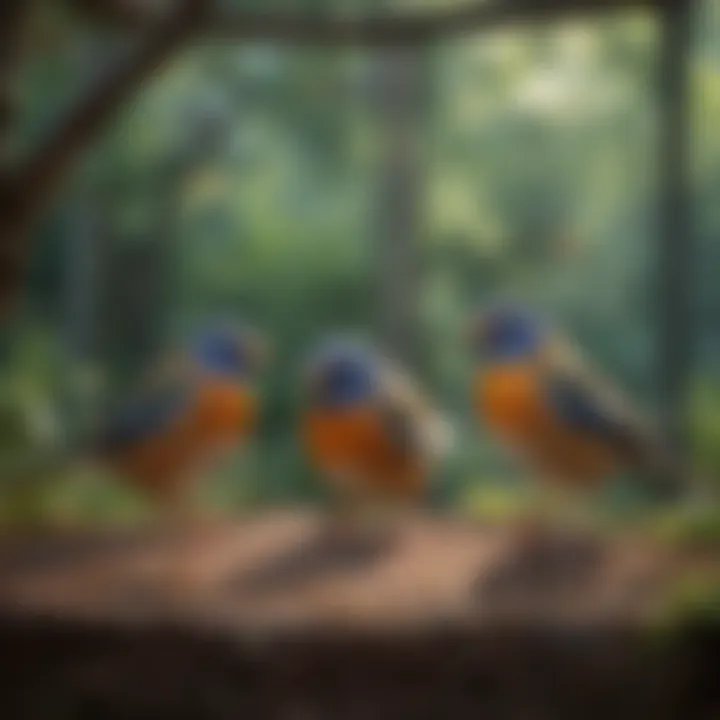
Understanding health considerations for birds in large enclosures is essential for their well-being. Large cages or aviaries allow for better space management, which can lead to healthier birds. Health issues in birds often stem from inadequate conditions, which can be prevented through proper design and maintenance practices. This section will explore monitoring bird health and strategies for preventing illness through enclosure design.
Monitoring Bird Health
Monitoring a bird's health is a crucial aspect of enclosure management. Regular assessments help owners detect potential health issues early on. Observational techniques can be employed to watch for signs of stress or illness. Key indicators of health include:
- Feather condition: Dull, missing, or ragged feathers may indicate dietary or health problems.
- Beak and claws: Overgrown beaks or claws suggest that the bird may not have suitable materials for wear and needs attention.
- Behavior: Changes in eating habits, aggression, or lethargy can signal underlying health issues.
Involvement of an avian veterinarian is recommended for routine check-ups. This ensures that birds receive vaccinations and preventive care as needed. Such vigilance contributes to a longer, healthier life for the birds.
Preventing Illness Through Design
Design plays a significant role in preventing illnesses among birds. Two major elements should be considered: Ventilation and Sunlight.
Ventilation
Proper ventilation is a top priority in large bird enclosures. Adequate airflow helps to control humidity and temperature, which can reduce the risk of respiratory diseases. The key characteristic of ventilation is that it promotes air exchange without causing drafts, which can stress birds.
Ventilation systems should encourage a gentle flow of fresh air while expelling stale air. Natural ventilation options, like windows and vents, can be very effective. One unique feature is that good ventilation limits the accumulation of harmful substances, such as airborne pathogens or mold, which can thrive in still air. The advantage of incorporating this into enclosure design is that it fosters a healthier environment for birds.
Sunlight
Sunlight is another vital aspect of an effective enclosure design. Birds require natural light to maintain their circadian rhythms, which affects their hormonal balance and overall health. A key characteristic of sunlight is its role in vitamin D synthesis, essential for calcium absorption in birds.
Incorporating natural sunlight into enclosures can be done through well-placed windows or areas where there is direct light exposure. A unique feature of sunlight is its positive effect on bird behavior, often leading to increased activity levels and a more enriched environment. However, too much direct sun can lead to overheating, so shade areas must be included. The challenge of balancing sunlight without risking heat stress is essential in the design of bird enclosures.
In summary, the health of birds in large enclosures is closely tied to diligent monitoring and thoughtful design choices. These actions create a habitat conducive to the overall well-being of pet birds.
Providing a well-ventilated space and allowing for appropriate sunlight access ensures that birds thrive. Furthermore, regular health checks and assessments should be integral to any bird owner's routine. By prioritizing these considerations, owners can foster an environment where birds can express their natural behaviors and lead healthy lives.
Case Studies of Successful Large Bird Enclosures
Case studies of successful large bird enclosures provide valuable insights for both novice and experienced bird owners. These examples illustrate practical applications of design principles, material choices, and maintenance strategies. They also reveal how well-planned environments can significantly enhance the quality of life for birds. By analyzing these case studies, we can identify key factors that lead to success in creating bird-friendly habitats.
Such studies often highlight various elements, including the integration of naturalistic features and the ways in which these spaces promote behavioral health. Understanding the successes—and sometimes failures—of existing enclosures gives new and existing bird owners a roadmap for their own endeavors.
"A well-structured and maintained enclosure can profoundly impact a bird's well-being. It is not just about size; it's about how that space is used and cared for."
Residential Examples
In residential settings, many bird owners have successfully created expansive enclosures that cater to the specific needs of their pets. These installations often prioritize functionality while being visually appealing. For example, enclosures that use abundant natural light can reduce stress in birds and encourage natural behaviors. In one particular case, a couple integrated a large outdoor aviary with planting shrubs, trees, and even artificial water features. This layout encouraged foraging behaviors and allowed the birds to enjoy their natural instincts.
Several residential examples have included:
- Diverse Plant Life: Incorporating plants that are safe for birds ensures a natural atmosphere while providing additional enrichment.
- Proper Furniture: Using perches, swings, and toys creates a stimulating environment. These elements encourage exercise and thoughtful exploration.
- Temperature Control: Insulating the enclosure properly protects birds from temperature extremes, which is crucial for their health.
Such residential setups consistently demonstrate that when the goals include not only the birds' physical needs but also their mental and emotional needs, the outcomes are markedly positive.
Public Aviaries
Public aviaries offer another perspective on successful large bird enclosures. These spaces often cater to a wide array of bird species and must be designed to accommodate various needs in a shared environment. Public aviaries frequently serve educational purposes and aim to inspire visitors about avian conservation efforts. For instance, the San Diego Zoo’s aviary showcases how comprehensive habitat design integrates native flora and monitored flight space safely for various birds. These considerations can apply to private enclosures as well.
- Species Diversity: Public aviaries make use of diverse species, which can also teach bird owners about compatibility and social dynamics in a larger group setting.
- Interactive Displays: Many public aviaries include educational signage that promotes learning about the birds' natural habitats and behaviors, further emphasizing the importance of environment in avian health.
- Regular Maintenance and Staff Involvement: Staffing allows for constant oversight, ensuring that the enclosures remain clean and that birds receive proper medical care when needed.
Remarkably, the best practices observed in both residential and public aviaries have laid down a solid foundation for future developments in large bird enclosures. These case studies reinforce the need for careful consideration of design, maintenance, and the emotional well-being of birds.
Challenges Unique to Large Bird Enclosures
Understanding the unique challenges presented by large bird enclosures is essential for creating a successful environment for your avian companions. These enclosures must cater to the specific needs of birds while ensuring their safety, health, and overall well-being. Acknowledging and addressing these challenges can significantly enhance the experience for both birds and their owners.
Behavioral Issues
Large bird enclosures can sometimes lead to behavioral challenges for the birds. Avian species are social animals that typically thrive in groups. When housed in large enclosures, some birds may experience disruption in their natural behaviors. Issues, such as aggression, territoriality, and anxiety, may arise due to overcrowding or incompatible species sharing the same space.
Additionally, some birds may develop repetitive behaviors, known as stereotypies, if the enclosure lacks sufficient stimulation or enrichment. These may include excessive screaming, feather plucking, or pacing. To mitigate these behavioral problems, it is vital to observe individual birds closely and provide environmental enrichment. This can involve creating varied spaces within the enclosure, allowing natural social interaction, and incorporating elements that engage the birds’ curiosity.
Resource Allocation
Resource allocation presents another challenge unique to large bird enclosures. Providing necessary resources for multiple birds can strain any system. This includes food, water, and space for rest and play. In larger setups, it can also mean ensuring adequate space for each bird to establish its territory without overcrowding.
To address resource allocation effectively, owners should consider the following factors:
- Food Distribution: Multiple feeding stations can accommodate various dietary preferences while preventing competition for food.
- Water Sources: Ensuring easy access to clean water is crucial, as larger enclosures may require multiple water dishes or automatic systems.
- Space Planning: Careful design can prevent overuse of certain areas and help maintain a balance in resource distribution.
Owners must engage in thorough planning for both behavioral and resource challenges to foster a nurturing and thriving environment for their birds.
Future Trends in Large Bird Enclosure Design
The design of large bird enclosures is evolving, influenced by advancements in technology and growing awareness about sustainability. This section will delve into how these trends redefine the way we think about bird care and habitat construction. As we explore integrating technology and sustainable practices, it will become clear that these elements not only enhance the living conditions of birds but also support the responsibilities of their owners.
Integrating Technology
Technology plays a crucial role in modernizing large bird enclosures. First, smart monitoring systems have emerged. These systems allow bird owners to track temperature, humidity, and even the health status of their birds in real-time. The integration of sensors can provide alerts if conditions fall outside optimal ranges, which is vital for avian health.
Remote-controlled lighting and heating systems also offer convenience. Owners can adjust these settings from afar through mobile apps. This technology ensures that birds experience consistent day-night cycles, which is important for their natural behavior and well-being.
Another interesting development is the use of automated feeding systems. These devices dispense food at scheduled times, which helps maintain a routine for the birds. Additionally, they can help reduce waste by monitoring food intake and distributing portions accordingly.
Sustainability Practices
Sustainability in bird enclosure design is not just a trend; it is a necessity. With an eye toward environmental responsibility, many designers are incorporating eco-friendly materials into their projects. For instance, recycled plastics and sustainable timber are excellent choices. They provide durability without compromising on the environment.
Water conservation is another critical aspect. Enclosures can be equipped with rainwater collection systems. These systems collect runoff from roofs to provide fresh water for birds, promoting a self-sustaining environment.
Moreover, energy-efficient solutions such as solar panels offer a way to power lighting and heating systems. This reduces reliance on non-renewable resources and lowers operating costs. Bird owners can contribute to a more sustainable future while enhancing the lives of their feathered companions.















